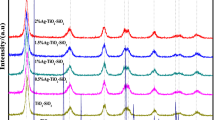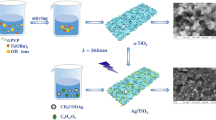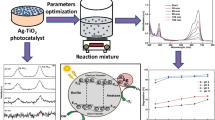Abstract
Ag-TiO2/SiO2 materials were synthesized with 1, 3, 5, and 10 wt% Ag contents and extensively characterized by different techniques, including XRD, SEM, TEM, XPS, BET, UV–VIS, EPR, and PL spectroscopy. Subsequently, the activity of these materials in the degradation of a model volatile organic compound (n-hexane) was compared by testing in a continuous gas–solid photoreactor. Loading with Ag induced stabilization of the brookite phase and crystal growth. TEM images showed d-spacing values corresponding to anatase and metallic silver. The specific surface area was lower in the Ag-modified catalysts, probably due to the blocking of the silica gel pores by Ag nanoparticles, whose size (~ 20 nm) was larger than the silica pores (~ 1.98 nm). SEM–EDS images showed heterogeneous distribution of Ag on the surface of the materials. XPS spectra showed bands referring to Ag+ and Ag0 3d, and Ti4+ and Ti3+ 2p. EPR analyses showed that silver loading of TiO2/SiO2 greatly increased the occurrence of oxygen vacancies in the material. Finally, the band gap energies calculated from the UV–VIS spectra were lower in the silver-containing catalysts, dropping from 3.25 to 3.17 eV in the optimal material. Under visible light, while TiO2/SiO2 showed no photoactivity, the Ag-modified materials presented satisfactory steady-state performance (46.4% n-hexane removal).
Graphical abstract









Similar content being viewed by others
Data availability
All data generated or analyzed during this study are included in this published article and its supplementary information file.
References
Schneider J, Matsuoka M, Takeuchi M et al (2014) Understanding TiO2 photocatalysis mechanisms and materials. Chem Rev 114:9919–9986. https://doi.org/10.1021/cr5001892
Lim TH, Kim SD (2004) Trichloroethylene degradation by photocatalysis in annular flow and annulus fluidized bed photoreactors. Chemosphere 54:305–312. https://doi.org/10.1016/S0045-6535(03)00753-7
Kamal MS, Razzak SA, Hossain MM (2016) Catalytic oxidation of volatile organic compounds (VOCs)-a review. Atmos Environ 140:117–134. https://doi.org/10.1016/j.atmosenv.2016.05.031
Zhang X, Gao B, Creamer AE et al (2017) Adsorption of VOCs onto engineered carbon materials: a review. J Hazard Mater 338:102–123. https://doi.org/10.1016/j.jhazmat.2017.05.013
Ozturk B, Yilmaz D (2006) Absorptive removal of volatile organic compounds from flue gas streams. Process Saf Environ Prot 84:391–398. https://doi.org/10.1205/psep05003
Li Q, Li FT (2020) Recent advances in surface and interface design of photocatalysts for the degradation of volatile organic compounds. Adv Coll Interface Sci 284:102275. https://doi.org/10.1016/j.cis.2020.102275
Huang Y, Ho SSH, Niu R et al (2016) Removal of indoor volatile organic compounds via photocatalytic oxidation: a short review and prospect. Molecules 21(1):56. https://doi.org/10.3390/molecules21010056
Khan F, i, Ghoshal AKr, (2000) Removal of volatile organic compounds from polluted air. J Loss Prev Process Ind 13:527–545. https://doi.org/10.1016/S0950-4230(00)00007-3
Mamaghani AH, Haghighat F, Lee C-S (2018) Gas phase adsorption of volatile organic compounds onto titanium dioxide photocatalysts. Chem Eng J 337:60–73. https://doi.org/10.1016/j.cej.2017.12.082
Ojala S, Pitkäaho S, Laitinen T et al (2011) Catalysis in VOC abatement. Top Catal 54:1224–1256. https://doi.org/10.1007/s11244-011-9747-1
Mansoubi H, Fatemi S, Mansourpour Z (2018) An efficient photo-catalytic VOC removal process by one-pot synthesized N-F/TiO2 nanoparticles in fluidized-spouted bed reactor. Part Sci Technol 36:162–171. https://doi.org/10.1080/02726351.2016.1236048
Mahdy AG, Emam AA, Mussa EA et al (2023) Synthesis and characterization of Li2Mn0.8Ni0.2SiO4/Mn3O4 nanocomposite for photocatalytic degradation of reactive blue (RB5) dye. J Inorg Organomet Polym 33:1280–1297. https://doi.org/10.1007/s10904-023-02572-5
Palharim PH, Caira’Amaro MCD, De Araújo Gusmão C et al (2022) Effect of temperature and time on the hydrothermal synthesis of WO3-AgCl photocatalysts regarding photocatalytic activity. Chem Eng Res Des 188:935–953. https://doi.org/10.1016/j.cherd.2022.10.045
Palharim PH, Diego L, dos Reis FB, Ramos B et al (2022) Effect of HCl and HNO3 on the synthesis of pure and silver-based WO3 for improved photocatalytic activity under sunlight. J Photochem Photobiol, A 422:113550. https://doi.org/10.1016/j.jphotochem.2021.113550
Basseem M, Emam AA, Kamal FH et al (2023) Novel functionalized of ZnO with Sm3+, La3+, and Sr2+/ZnO single and tri-doped nanomaterials for photocatalytic degradation: synthesis, DFT, kinetics. J Mater Sci 58:13346–13372. https://doi.org/10.1007/s10853-023-08829-1
Basseem M, Emam AA, Kamal FH et al (2023) Photocatalytic activity of co-doped NPs based on ZnO as a new class of anti-microbial agents: Synthesis, characterization, kinetics, isotherm, and in silico molecular docking simulation. Appl Organomet Chem 37(10):e7238. https://doi.org/10.1002/aoc.7238
Shayegan Z, Lee CS, Haghighat F (2018) TiO2 photocatalyst for removal of volatile organic compounds in gas phase–a review. Chem Eng J 334:2408–2439. https://doi.org/10.1016/j.cej.2017.09.153
Xu G, Zheng Z, Wu Y, Feng N (2009) Effect of silica on the microstructure and photocatalytic properties of titania. Ceram Int 35:1–5. https://doi.org/10.1016/j.ceramint.2007.09.008
de Luna MDG, Laciste MT, Tolosa NC, Lu MC (2018) Effect of catalyst calcination temperature in the visible light photocatalytic oxidation of gaseous formaldehyde by multi-element doped titanium dioxide. Environ Sci Pollut Res 25:15216–15225. https://doi.org/10.1007/s11356-018-1720-0
Zhang H, Jiang Y, Zhou B et al (2021) Preparation and photocatalytic performance of silver-modified and nitrogen-doped TiO2 nanomaterials with oxygen vacancies. New J Chem 45:4694–4704. https://doi.org/10.1039/d0nj04755d
Yguerabide J, Yguerabide EE (1998) Light-scattering submicroscopic particles as highly fluorescent analogs and their use as tracer labels in clinical and biological applications II. Exp Charact Anal Biochem 262:157–176. https://doi.org/10.1006/abio.1998.2760
Fang M, Tan X, Liu Z et al (2021) Recent progress on metal-enhanced photocatalysis: a review on the mechanism. Research 2021:9794329. https://doi.org/10.34133/2021/9794329
Dey D, Halder N, Misra KP et al (2020) Systematic study on the effect of Ag doping in shaping the magnetic properties of sol-gel derived TiO2 nanoparticles. Ceram Int 46:27832–27848. https://doi.org/10.1016/j.ceramint.2020.07.282
Einaga H (2006) Effect of silver deposition on tio for photocatalytic oxidation of benzene in the gas phase. React Kinet Catal Lett 88:357–362. https://doi.org/10.1007/s11144-006-0072-9
Li X, Zou X, Qu Z et al (2011) Photocatalytic degradation of gaseous toluene over Ag-doping TiO2 nanotube powder prepared by anodization coupled with impregnation method. Chemosphere 83:674–679. https://doi.org/10.1016/j.chemosphere.2011.02.043
Liao G, Fang J, Li Q et al (2019) Ag-Based nanocomposites: Synthesis and applications in catalysis. Nanoscale 11:7062–7096. https://doi.org/10.1039/c9nr01408j
Santos LM, Machado WA, França MD et al (2015) Structural characterization of Ag-doped TiO2 with enhanced photocatalytic activity. RSC Adv 5:103752–103759. https://doi.org/10.1039/c5ra22647c
Yaqoob AA, Umar K, Ibrahim MNM (2020) Silver nanoparticles: various methods of synthesis, size affecting factors and their potential applications–a review. Appl Nanoscie (Switzerland) 10:1369–1378. https://doi.org/10.1007/s13204-020-01318-w
Zhao W, Zhang Z, Zhang J et al (2016) Synthesis of Ag/TiO2/graphene and its photocatalytic properties under visible light. Mater Lett 171:182–186. https://doi.org/10.1016/j.matlet.2016.02.063
Li Z, Wang S, Wu J, Zhou W (2022) Recent progress in defective TiO2 photocatalysts for energy and environmental applications. Renew Sustain Energy Rev 156:111980. https://doi.org/10.1016/j.rser.2021.111980
Na S, Seo S, Lee H (2020) Recent developments of advanced Ti3+-self-doped TiO2 for efficient visible-light-driven photocatalysis. Catalysts 10(6):679. https://doi.org/10.3390/catal10060679
Xiu Z, Guo M, Zhao T et al (2020) Recent advances in Ti3+ self-doped nanostructured TiO2 visible light photocatalysts for environmental and energy applications. Chem Eng J 382:123011. https://doi.org/10.1016/j.cej.2019.123011
Chao HE, Yun YU, Xingfang HU, Larbot A (2003) Effect of silver doping on the phase transformation and grain growth of sol-gel titania powder. J Eur Ceram Soc 23:1457–1464. https://doi.org/10.1016/S0955-2219(02)00356-4
Gusmão CA, Palharim PH, Ramos B, Teixeira ACSC (2021) Enhancing the visible-light photoactivity of silica-supported TiO2 for the photocatalytic treatment of pharmaceuticals in water. Environ Sci Pollut Res 29:42215–42230. https://doi.org/10.1007/s11356-021-16718-w
Puddu V, Choi H, Dionysiou DD, Puma GL (2010) TiO2 photocatalyst for indoor air remediation: Influence of crystallinity, crystal phase, and UV radiation intensity on trichloroethylene degradation. Appl Catal B 94:211–218. https://doi.org/10.1016/j.apcatb.2009.08.003
Christoforidis KC, Figueroa SJA, Fernández-García M (2012) Iron-sulfur codoped TiO2 anatase nano-materials: UV and sunlight activity for toluene degradation. Appl Catal B 117–118:310–316. https://doi.org/10.1016/j.apcatb.2012.01.029
Laciste MT, de Luna MDG, Tolosa NC, Lu MC (2017) Degradation of gaseous formaldehyde via visible light photocatalysis using multi-element doped titania nanoparticles. Chemosphere 182:174–182. https://doi.org/10.1016/j.chemosphere.2017.05.022
Araña J, Alonso AP, Rodríguez JMD et al (2009) FTIR study of photocatalytic degradation of 2-propanol in gas phase with different TiO2 catalysts. Appl Catal B 89:204–213. https://doi.org/10.1016/j.apcatb.2008.11.027
Almeida Diniz L, Matsumoto D, Silva Costa Teixeira AC (2021) Photocatalytic degradation of n-hexane in a circulating fluidized bed: an investigation based on the freeboard entrainment model. Catal Today 361:109–116. https://doi.org/10.1016/j.cattod.2020.01.043
Bueno-Alejo CJ, Hueso JL, Mallada R et al (2019) High-radiance LED-driven fluidized bed photoreactor for the complete oxidation of n-hexane in air. Chem Eng J 358:1363–1370. https://doi.org/10.1016/j.cej.2018.09.223
Geng Q, Guo Q, Yue X (2010) Adsorption and photocatalytic degradation kinetics of gaseous cyclohexane in an annular fluidized bed photocatalytic reactor. Ind Eng Chem Res 49:4644–4652. https://doi.org/10.1021/ie100114e
Park JH, Seo YS, Kim HS, Kim IK (2011) Photodegradation of benzene, toluene, ethylbenzene and xylene by fluidized bed gaseous reactor with TiO2/SiO2 photocatalysts. Korean J Chem Eng 28:1693–1697. https://doi.org/10.1007/s11814-011-0021-9
Liu C, Yang D, Jiao Y et al (2013) Biomimetic synthesis of TiO2-SiO2-Ag nanocomposites with enhanced visible-light photocatalytic activity. ACS Appl Mater Interfaces 5:3824–3832. https://doi.org/10.1021/am4004733
Lee SK, Kim JS, Kim IK, Lee JK (2006) Photodegradation of a volatile organic compound by fluidized bed reactor with TiO2/SiO2 and metal-TiO2/SiO2. In: Rhee H-K, Nam I-S, Park JM (eds) Studies in surface science and catalysis. Elsevier, pp 581–584
Chen Y, Wang K, Lou L (2004) Photodegradation of dye pollutants on silica gel supported TiO2 particles under visible light irradiation. J Photochem Photobiol, A 163:281–287. https://doi.org/10.1016/j.jphotochem.2003.12.012
Liao J, Yang F, Wang C-Z, Lin S (2018) The crystal facet-dependent electrochemical performance of TiO2 nanocrystals for heavy metal detection: theoretical prediction and experimental proof. Sens Actuators, B Chem 271:195–202. https://doi.org/10.1016/j.snb.2018.05.067
Wu X-P, Yang M-Y, Zhou Z-J, et al (2023) Chapter 16 - Photocatalysis. In: García-Iriepa C, Marazzi M (eds) Theoretical and Computational Photochemistry. Elsevier, pp 387–415
Di Paola A, Cufalo G, Addamo M et al (2008) Photocatalytic activity of nanocrystalline TiO2 (brookite, rutile and brookite-based) powders prepared by thermohydrolysis of TiCl4 in aqueous chloride solutions. Colloids Surf, A 317:366–376. https://doi.org/10.1016/j.colsurfa.2007.11.005
Mahshid S, Askari M, Ghamsari MS (2007) Synthesis of TiO2 nanoparticles by hydrolysis and peptization of titanium isopropoxide solution. J Mater Process Technol 189:296–300. https://doi.org/10.1016/j.jmatprotec.2007.01.040
Carp O, Huisman CL, Reller A (2004) Photoinduced reactivity of titanium dioxide. Prog Solid State Chem 32:33–177. https://doi.org/10.1016/j.progsolidstchem.2004.08.001
Tian Z, Du S, Cheng X et al (2022) The Role of oxygen vacancy in anatase to rutile transformation of TiO2. Cryst Growth Des 22:6852–6856. https://doi.org/10.1021/acs.cgd.2c01062
Elahifard M, Sadrian MR, Mirzanejad A et al (2020) Dispersion of defects in TiO2 semiconductor: oxygen vacancies in the bulk and surface of rutile and anatase. Catalysts 10(4):397. https://doi.org/10.3390/catal10040397
Bensouici F, Souier T, Dakhel AA et al (2015) Synthesis, characterization and photocatalytic behavior of Ag doped TiO2 thin film. Superlattices Microstruct 85:255–265. https://doi.org/10.1016/j.spmi.2015.05.028
Ly NH, Vasseghian Y, Joo S-W (2023) Plasmonic photocatalysts for enhanced solar hydrogen production: a comprehensive review. Fuel 344:128087. https://doi.org/10.1016/j.fuel.2023.128087
Khan MR, Chuan TW, Yousuf A et al (2015) Schottky barrier and surface plasmonic resonance phenomena towards the photocatalytic reaction: study of their mechanisms to enhance photocatalytic activity. Catal Sci Technol 5:2522–2531. https://doi.org/10.1039/c4cy01545b
Wang L, Sun Y, Xu B (2007) Comparison study on the microstructure of nanocrystalline TiO2 in different Ti-Si binary oxides. J Mater Sci Technol 23:604–610
Boukis N, Claussen N, Ebert K et al (1997) Corrosion screening tests of high-performance ceramics in supercritical water containing oxygen and hydrochloric acid. J Eur Ceram Soc 17:71–76. https://doi.org/10.1016/S0955-2219(96)00072-6
Braconnier B, Páez CA, Lambert S et al (2009) Ag- and SiO2-doped porous TiO2 with enhanced thermal stability. Microporous Mesoporous Mater 122:247–254. https://doi.org/10.1016/j.micromeso.2009.03.007
Neaţu Ş, Pârvulescu VI, Epure G et al (2009) M/TiO2/SiO2 (M=Fe, Mn, and V) catalysts in photo-decomposition of sulfur mustard. Appl Catal B 91:546–553. https://doi.org/10.1016/j.apcatb.2009.06.026
Suligoj A, Stangar UL, Ristic A et al (2016) TiO2–SiO2 films from organic-free colloidal TiO2 anatase nanoparticles as photocatalyst for removal of volatile organic compounds from indoor air. Appl Catal B 184:119–131. https://doi.org/10.1016/j.apcatb.2015.11.007
Liu X, Zhang Y, Matsushima S et al (2020) Photocatalytic oxidation process for treatment of gas phase benzene using Ti3+ self-doped TiO2 microsphere with sea urchin-like structure. Chem Eng J 402:126220. https://doi.org/10.1016/j.cej.2020.126220
Kumar R, El-Shishtawy RM, Barakat MA (2016) Synthesis and characterization of Ag-Ag2O/TiO2@polypyrrole heterojunction for enhanced photocatalytic degradation of methylene blue. Catalysts 6(6):76. https://doi.org/10.3390/catal6060076
Palomino RM, Hamlyn R, Liu Z et al (2017) Interfaces in heterogeneous catalytic reactions: ambient pressure XPS as a tool to unravel surface chemistry. J Electron Spectrosc Relat Phenom 221:28–43. https://doi.org/10.1016/j.elspec.2017.04.006
Ghattavi S, Nezamzadeh-Ejhieh A (2019) A brief study on the boosted photocatalytic activity of AgI/WO3/ZnO in the degradation of methylene blue under visible light irradiation. Desalin Water Treat 166:92–104. https://doi.org/10.5004/dwt.2019.24638
Nezamzadeh-Ejhieh A, Bahrami M (2015) Investigation of the photocatalytic activity of supported ZnO–TiO2 on clinoptilolite nano-particles towards photodegradation of wastewater-contained phenol. Desalin Water Treat 55:1096–1104. https://doi.org/10.1080/19443994.2014.922443
Lan D, Wu H, Puleo F, Liotta LF (2019) Bulk and surface characterization techniques of TiO2 and TiO2-doped oxides. In: Marcì G, Palmisano L (eds) Heterogeneous Photocatalysis. Elsevier, Amsterdam, pp 57–86. https://doi.org/10.1016/B978-0-444-64015-4.00003-1
Liang Y, Huang G, Xin X et al (2022) Black titanium dioxide nanomaterials for photocatalytic removal of pollutants: a review. J Mater Sci Technol 112:239–262. https://doi.org/10.1016/j.jmst.2021.09.057
Nair RV, Gummaluri VS, Matham MV, Vijayan C (2022) A review on optical bandgap engineering in TiO2 nanostructures via doping and intrinsic vacancy modulation towards visible light applications. J Phys D: Appl Phys 55(31):313003. https://doi.org/10.1088/1361-6463/ac6135
Wang L, Wang X, Yin J et al (2016) Silica induced oxygen vacancies in supported mixed-phase TiO2 for photocatalytic degradation of phenol under visible light irradiation. Catal Commun 87:98–101. https://doi.org/10.1016/j.catcom.2016.09.011
Vasilaki E, Vernardou D, Kenanakis G et al (2017) TiO2/WO3 photoactive bilayers in the UV–Vis light region. Appl Phys A 123:231. https://doi.org/10.1007/s00339-017-0837-1
Yao N, Huang J, Fu K et al (2016) Reduced interfacial recombination in dye-sensitized solar cells assisted with NiO:Eu3+, Tb3+ coated TiO2 film. Sci Rep 6:31123. https://doi.org/10.1038/srep31123
Lim SP, Pandikumar A, Lim HN et al (2015) Boosting photovoltaic performance of dye-sensitized solar cells using silver nanoparticle-decorated N, S-Co-Doped-TiO2 photoanode. Sci Rep 5:11922. https://doi.org/10.1038/srep11922
Tang B, Chen H, Peng H, Wang Z, Huang W (2018) Graphene modified TiO2 composite photocatalysts: Mechanism, Progress and Perspective. Nanomater 8(2):105. https://doi.org/10.3390/nano8020105
Patra KK, Bharad PA, Jain V, Gopinath CS (2019) Direct solar-to-hydrogen generation by quasi-artificial leaf approach: possibly scalable and economical device. J Mater Chem A 7:3179–3189. https://doi.org/10.1039/C8TA11307F
Mehrabadi Z, Faghihian H (2019) Clinoptilolite modified TiO2 for simultaneouos elimination of two herbicides; 2,4-D and MCPA by UV and sunlight-assisted photocatalytic degradation. Mater Res Bull 119:110569. https://doi.org/10.1016/j.materresbull.2019.110569
Le THT, Bui TT, Van Bui H et al (2021) TiO2 inverse opals modified by ag nanoparticles: a synergic effect of enhanced visible-light absorption and efficient charge separation for visible-light photocatalysis. Catalysts 11(7):761. https://doi.org/10.3390/catal11070761
de Araújo GC, Diniz LA, Ramos B, Câmara AG, Pacheco JG, Teixeira AC (2022) Optimization of TiO2/SiO2 photocatalysts in a LED-irradiated gas-solid photoreactor for air treatment. Chem Eng Res Des 185:223–238. https://doi.org/10.1016/j.cherd.2022.07.001
Acknowledgement
This study was financed in part by the Coordenação de Aperfeiçoamento de Pessoal de Nível Superior – Brasil (CAPES) – Finance Code 001. The authors also express their gratitude to the National Council of Scientific and Technological Development (CNPq, Brazil, grants #311230/2020-2 and #140347/2020-8) and to the São Paulo Research Foundation (FAPESP, grant 2019/24158-9) for financial support. Moreover, this research used facilities of the Brazilian Nanotechnology National Laboratory (LNNano), part of the Brazilian Centre for Research in Energy and Materials (CNPEM), a private non-profit organization under the supervision of the Brazilian Ministry for Science, Technology, and Innovations (MCTI). The Naga Vishnu Vardhan Mogili and Ângela Albuquerque Teixeira Neto staff are acknowledged for the assistance during the experiments (TEM-FEG-20210327, XPS-20220414). Finally, the authors would like to thank Dr. Jose Geraldo Pacheco for their valuable contribution toward conducting photoluminescence spectroscopy analyses at Federal University of Pernambuco (UFPE).
Funding
Coordenação de Aperfeiçoamento de Pessoal de Nível Superior—Brasil (CAPES—Coordination for the Improvement of Higher Education Personnel)–Finance Code 001, National Council of Scientific and Technological Development (CNPq, Brazil, grants #311230/2020–2 and #140347/2020–8), and the São Paulo Research Foundation (FAPESP, grant 2019/24158–9).
Author information
Authors and Affiliations
Contributions
CAG helped in conceptualization, methodology, validation, formal analysis, investigation, writing—original draft, and visualization. PHP was involved in methodology, validation, formal analysis, investigation, writing—original draft, and visualization. BR participated in formal analysis, investigation, writing–original draft, and visualization. ORJ helped in formal analysis, investigation, and visualization. DG was involved in investigation, visualization, and writing—review and editing. ACSCT participated in conceptualization, validation, resources, writing—original draft, writing—review and editing, supervision, and funding acquisition. All authors read and approved the final manuscript.
Corresponding authors
Ethics declarations
Conflict of interest
The authors declare that they have no competing interests.
Ethical approval
Not applicable.
Consent to participate
Not applicable.
Consent for publication
Not applicable.
Additional information
Handling Editor: David Cann.
Publisher's Note
Springer Nature remains neutral with regard to jurisdictional claims in published maps and institutional affiliations.
Supplementary Information
Below is the link to the electronic supplementary material.
Rights and permissions
Springer Nature or its licensor (e.g. a society or other partner) holds exclusive rights to this article under a publishing agreement with the author(s) or other rightsholder(s); author self-archiving of the accepted manuscript version of this article is solely governed by the terms of such publishing agreement and applicable law.
About this article
Cite this article
Gusmão, C.d., Palharim, P.H., Ramos, B. et al. Enhanced visible light photocatalytic VOC oxidation via Ag-loaded TiO2/SiO2 materials. J Mater Sci 59, 1215–1234 (2024). https://doi.org/10.1007/s10853-023-09285-7
Received:
Accepted:
Published:
Issue Date:
DOI: https://doi.org/10.1007/s10853-023-09285-7




